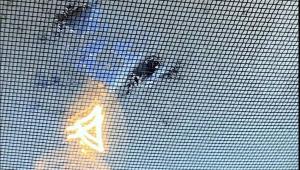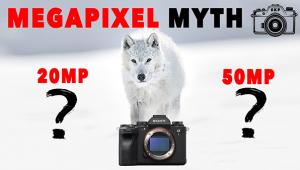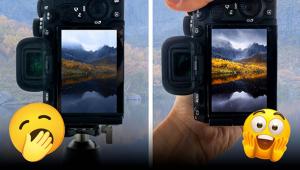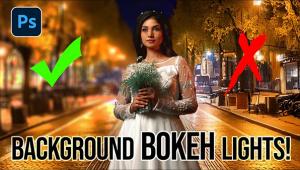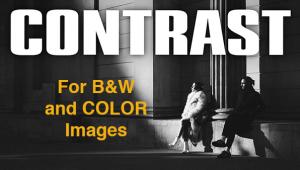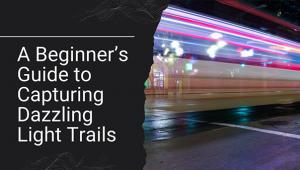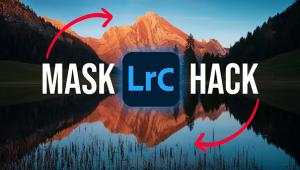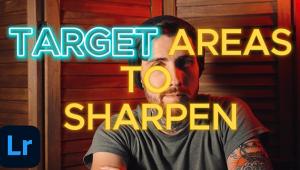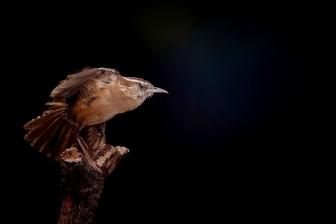A Leica Panoramic Head; A Bit Before Its Time, Though A Tad Off Its Mark Page 2
Something that is not immediately obvious is that the wider the lens, the harder
it is to get convincing joins. The immediate and natural thought is that it
should be most convincing to join together a smaller number of wide angle shots--seven
35mm shots, maybe, or even five 21mm shots--rather than a larger number
of shots taken with a longer lens, but the exact opposite is true. The distortions
and mismatches of perspective at the edges of each image become more and more
obvious as the field of view gets wider, so that although there are fewer joins,
they look worse. A much better idea is to shoot more pictures with a longer
lens.
But you can carry this too far. With the 13.5cm ring (FARLY) there are no fewer than 25 clicks, each individually numbered (click 26 is click 1 again), so each click is 14.4Þ. There's no vertical-camera option on this one. Given that the horizontal coverage of a 13.5cm lens on the 24x36mm format is a fraction over 15Þ, there is once again very little room for overlap, but then again, you don't need it as much. Even so, you have used well over half a roll of film to shoot a full panorama, and you will have the drawback that while you cover 360Þ horizontally, your vertical coverage will be a mere 10Þ or so, as compared with 27Þ from the 5cm lens. And, of course, you have to print, cut, and glue 25 pictures instead of 14 or 10.
Suddenly, it is clear why digital stitching is a much better idea. Not only is it a lot easier: it is also possible to "lose" awkward perspective transitions with good stitching programs. Whether you assemble your panoramas by traditional cut and paste, or digitally, it really looks rather as if Ernst Leitz didn't get it quite right with this one: a simple rotating head, graduated in degrees (as supplied, for example, by Linhof) is a lot easier. You can work out the angle of rotation for any given focal length on any given format for yourself, or you can simply measure it: line up (say) a tree at one end of the format, note the angle, rotate it until the tree is at the other end of the format, and note the angle again. The difference between them is the angle of coverage, and the desirable angle of rotation will be less.
What's a Leica panoramic kit worth? Whatever you can get for it. I'd be surprised nowadays to find a bare FARUX for much under $75, even at a camera fair, but equally, I'd say you'd need to be obsessive to pay over $200 for one, which doesn't stop people asking $200 and more. A FIAMA, being rarer, should go for more than a FARUX, and a FIAVI camera cradle would be another $75-$150. DOOLU spirit levels typically go for a few tens of dollars, so a full set (FARUX, FIAVI, DOOLU/FIBLA) should start at around $200 and max out at around double that--though again, you'd need to want it pretty badly to pay $400 or so, and (as ever with Leica kit) condition is everything: mint, boxed, and with the original receipts, it could double again, though I'd be fairly surprised at that.
Accessory rings for other focal lengths on a FARUX should be worth very nearly as much as a complete FARUX, because they are rarer: this must be especially true of the 7.3cm FAWAG and 10.5cm FASKI. But again, the demand must be tiny, not much bigger than the supply, and a ring on its own is likely to be unrecognized for what it is anyway, so you might find one for $10 or less. But a FARUX plus FASKI could easily top $300 together...
But you can carry this too far. With the 13.5cm ring (FARLY) there are no fewer than 25 clicks, each individually numbered (click 26 is click 1 again), so each click is 14.4Þ. There's no vertical-camera option on this one. Given that the horizontal coverage of a 13.5cm lens on the 24x36mm format is a fraction over 15Þ, there is once again very little room for overlap, but then again, you don't need it as much. Even so, you have used well over half a roll of film to shoot a full panorama, and you will have the drawback that while you cover 360Þ horizontally, your vertical coverage will be a mere 10Þ or so, as compared with 27Þ from the 5cm lens. And, of course, you have to print, cut, and glue 25 pictures instead of 14 or 10.
Suddenly, it is clear why digital stitching is a much better idea. Not only is it a lot easier: it is also possible to "lose" awkward perspective transitions with good stitching programs. Whether you assemble your panoramas by traditional cut and paste, or digitally, it really looks rather as if Ernst Leitz didn't get it quite right with this one: a simple rotating head, graduated in degrees (as supplied, for example, by Linhof) is a lot easier. You can work out the angle of rotation for any given focal length on any given format for yourself, or you can simply measure it: line up (say) a tree at one end of the format, note the angle, rotate it until the tree is at the other end of the format, and note the angle again. The difference between them is the angle of coverage, and the desirable angle of rotation will be less.
What's a Leica panoramic kit worth? Whatever you can get for it. I'd be surprised nowadays to find a bare FARUX for much under $75, even at a camera fair, but equally, I'd say you'd need to be obsessive to pay over $200 for one, which doesn't stop people asking $200 and more. A FIAMA, being rarer, should go for more than a FARUX, and a FIAVI camera cradle would be another $75-$150. DOOLU spirit levels typically go for a few tens of dollars, so a full set (FARUX, FIAVI, DOOLU/FIBLA) should start at around $200 and max out at around double that--though again, you'd need to want it pretty badly to pay $400 or so, and (as ever with Leica kit) condition is everything: mint, boxed, and with the original receipts, it could double again, though I'd be fairly surprised at that.
Accessory rings for other focal lengths on a FARUX should be worth very nearly as much as a complete FARUX, because they are rarer: this must be especially true of the 7.3cm FAWAG and 10.5cm FASKI. But again, the demand must be tiny, not much bigger than the supply, and a ring on its own is likely to be unrecognized for what it is anyway, so you might find one for $10 or less. But a FARUX plus FASKI could easily top $300 together...
- Log in or register to post comments







